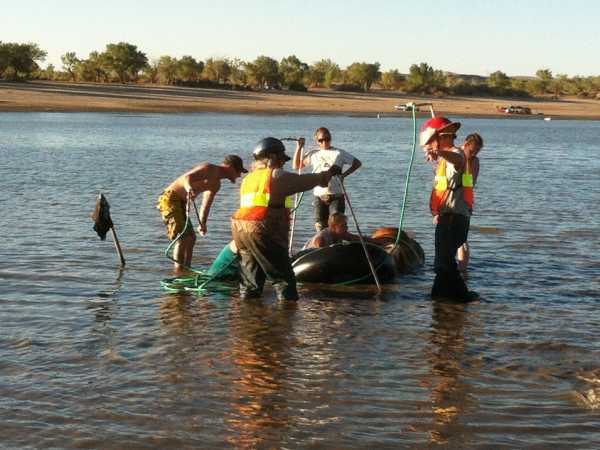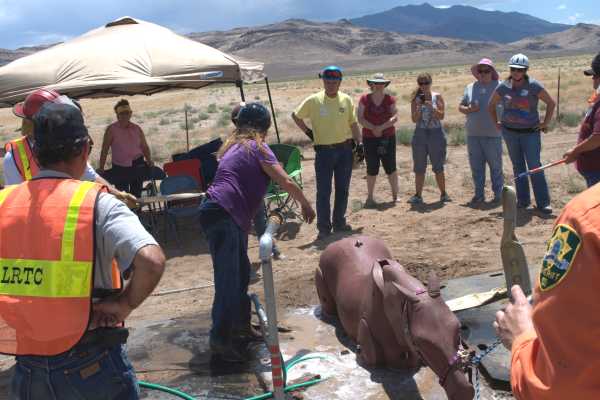
Once an overall assessment of the scene and the animal's needs have been completed and the scene is secure, the use of proper equipment and techniques are critical in ensuring a high probability of success with minimal risks to the rescuers and the animal involved.
With a large animal in a bog, ditch or hole, a sling and straps appropriate for the animal being rescued are essential. Professionally designed straps and a sling are preferred however wide web materials such as commercial truckers' straps can make do if appropriately applied.
An appropriately sturdy lifting apparatus will be required. This apparatus could be an A-frame, bipod, bucket loader, tow truck or any other device of sufficient height and stability to lift the animal vertically from its entrapment. Trying to drag a solidly trapped large animal horizontally can often lead to disastrous results, so devising some form of vertical lift is essential.
(Note: Open trenches where mud is not involved are instances where sometimes a slip sheet can be placed against one side and the animal vectored horizontally out of the confined space.)
In an incident involving an open trench, some form of shoring is generally required to prevent the trench from collapsing during the rescue operation. In addition, the trench may require some stabilization at the lip of the trench with glide sheets or plywood to prevent the edge of the trench breaking away and onto the animal when someone steps close to the edge.
With any bog or trench rescue, plywood or glide sheets should be deployed to provide stability for rescuers working close to the trench edge or bogged horse.
The person employing tools near the horse stands on a solid "platform" and is also secured by a strap held by an
adjacent rescuer. If she were to slip or if the horse suddenly moved, she could be quickly be pulled to safety.
While safety harnesses are the preferred means of securing rescuers, long loops of webbing can "make do" in a pinch.
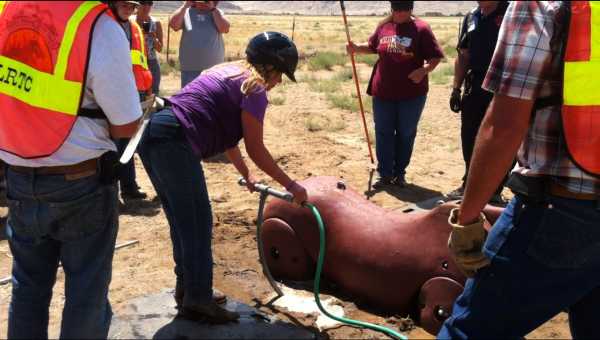
Tools specific to extricating a bogged horse
Suction is a significant factor when dealing with a large animal, or even a human, who is mired in wet sand or dirt, and in instances where soil has fallen and compacted where the animal or person is trapped.
Here is how significant the suction issue is. In one training exercise we conducted a demonstration where we first attempted to lift the horse using a bucket loader without addressing the suction issue. The suction actually caused the rear tires of the loader to leave the ground during a lift attempt. With a live animal, even if the lifting apparatus was sufficient to extricate the animal without the machine becoming unstable, such extreme force applied to the animal could cause fatal injuries. Therefore in in these situations some provisions need to be made to inject air or water next to the animal's hooves.
We use ½ inch diameter jetting wands (also known as "stingers" or "mud lances" depending on which country you are in) that we supply water through conventional garden hoses from our mobile water supply unit. These wands are similar in design to those used in trench compaction, however the flow required to break suction in an animal extrication is comparatively small. An off-the-shelf 1 to 4 garden hose manifold provides simultaneous flow to all four wands. The wands can be also supplied by a domestic water source or a fire fighting vehicle that has a booster tank. Wands designed to inject low pressure air from a portable air supply can be similarly effective. (In the experiment the mannequin was easily lifted from the bog once the suction issue had been addressed.
Recommended Step-by-step Procedures
Once the scene is secure, personnel are organized, the required equipment is in place, an action plan has been established and a veterinarian is on-scene, we have found that the equipment and procedures outlined below produce good results.
1. Protect the horse's head and eyes.
Someone should be assigned to maintain control of the horse's head for the purpose of protecting the head and especially the eyes from injury. While upright, a weakened or sedated horse may need assistance to prevent its muzzle and nostrils from sinking into mud or soft dirt. (Once extricated, if the horse cannot stand up and a formal head protector is not at hand, a personal flotation device or even a lady's bra or camisole can be used to shield the eyes, and a bulky item can be placed between the horse's head and the ground.)
The "head" person should not be assigned any other tasks but to protect the horse's head.

2. Insert a Nikopoulos needle under the horse.
A Nikopoulos needle is a U-shaped length of one inch pipe with small holes drilled along the pipe and an attachment ring welded to the tip. When connected to a water source it will safely jet its way under the animal and come out the other side. At that point the water should be turned off and a lifting strap attached.
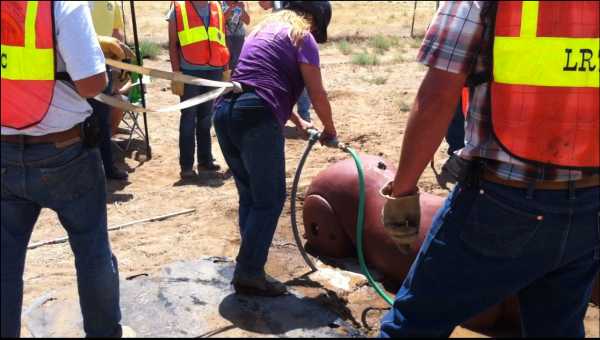
3. Attach the strap to the needle.
The strap can be attached to the needle via a small rope or piece of webbing. In many instances one side of the bog will likely be more firm than the other. In these instances persons on the less firm side should avoid approaching the horse and use poles with hooks, and the attachment should be made from the "safe" side, even if that means leaning over the horse. (A rescuer sinking under a large bogged animal can add a huge complication to the operation. As we have experienced in real life, what appears to be firm soil can simply be a thin crust that suddenly gives way.)
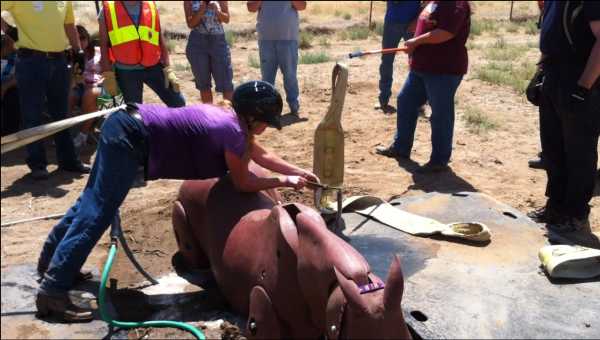
4. Retract the needle and draw the strap under the horse.
This procedure should be exercised carefully so as not to get the strap hung up on the horse while passing under. Turning the water back on while retracting the Nikopoulos needle and pulling the strap under the horse can lessen the chances of the strap getting hung up.
Note: When using professional rescue straps that have rings along one face, make sure that the rings face away from the horse when pulling the strap under the horse!
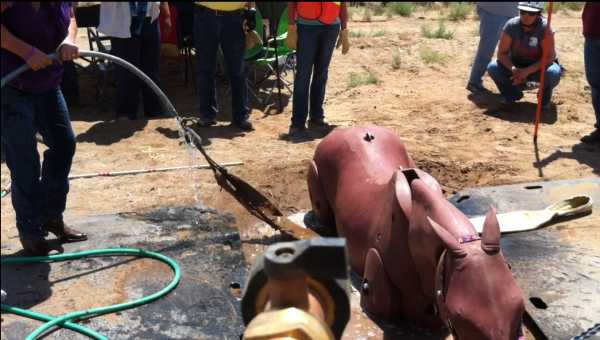
5. Repeat the process for the forward strap
A horse's rib cage typically has more depth than its abdomen so the forward application of the Nikopoulos needle requires a more vertical start to avoid striking the side of the horse's sternum.
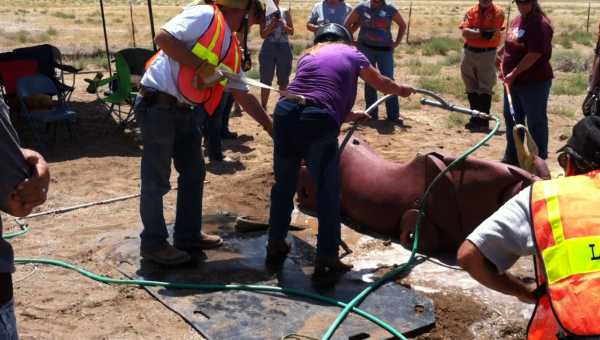
6. Fasten the ends of the straps together
Fastening the ends of the straps together prevents the end of a strap from disappearing into the mud and sets up the straps to be attached to the Becker sling.
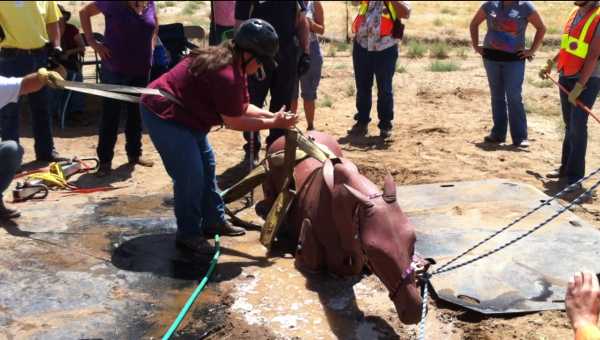
7. Attach a chest strap
This is a critical step when extricating a large animal. Without a chest strap you run a great chance that the animal could slide forward out of the sling when lifted and land on its head!
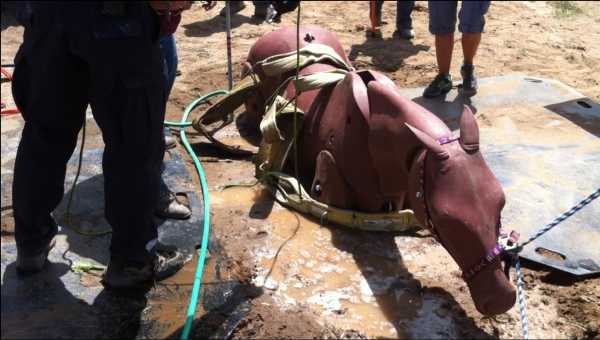
8. Sedate the horse before lifting?
In most instances bogged horses will be exhausted and very compliant on release, likely needing to lay down. However, there could be instances it may be safer that the horse be sedated prior to lifting. The horse may also require an IV line to be established and fluids administered prior to its extrication. The stability of the ground next to the horse's neck may affect this decision although in most cases a veterinarian can access the horse. If the horse is sedated, it is important to consider the effects that sedation may have on the horse as it starts to wear off and the horse attempts to become active, and also the potential impacts of sedation on hypothermia.
| 



